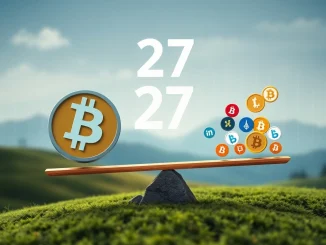
Hold onto your hats, crypto enthusiasts! The narrative around Bitcoin’s environmental impact is undergoing a seismic shift. For years, critics have pointed fingers at Bitcoin mining’s energy consumption, often highlighting its reliance on fossil fuels like coal. But guess what? The tables are turning, and the latest data reveals a truly revolutionary change in how Bitcoin is powered. Prepare to be amazed by the dramatic decline of coal in Bitcoin mining and the incredible surge of renewable energy.
The Astonishing Plunge of Coal in Bitcoin Mining
Let’s talk numbers. A groundbreaking report by the MiCA Crypto Alliance and Nodiens, as highlighted by Cointelegraph, has unveiled a stunning trend: the dependence of Bitcoin mining on coal energy has plummeted from a staggering 63% in 2011 to a mere 20% in 2024. That’s a dramatic decrease of over two-thirds in just 13 years! This isn’t just a minor adjustment; it’s a fundamental transformation of the energy landscape powering the world’s leading cryptocurrency.
Imagine this visual: back in 2011, for every 10 units of energy fueling Bitcoin mining, 6 were derived from coal. Fast forward to today, and that number has shrunk to just 2 out of 10. This isn’t just good news for environmentalists; it’s a testament to the Bitcoin industry’s growing commitment to sustainability.
Renewable Energy Bitcoin: A Greener Future Takes Root
So, what’s filling the energy void left by coal? The answer is as bright as the sun and as powerful as the wind: renewable energy Bitcoin mining is on the rise! The report reveals an average annual growth rate of 5.8% in renewable energy usage within the Bitcoin mining sector. This steady climb is a clear indicator that miners are actively seeking and adopting cleaner, more sustainable power sources.
But what exactly constitutes ‘renewable energy’ in this context? It encompasses a range of sources, including:
- Hydropower: Harnessing the power of flowing water, a long-established and reliable renewable source.
- Wind Power: Capturing the kinetic energy of wind through turbines, increasingly cost-effective and widely available.
- Solar Power: Converting sunlight directly into electricity using photovoltaic panels, rapidly becoming more affordable and efficient.
- Geothermal Energy: Tapping into the Earth’s internal heat for power generation, a consistent and often underutilized resource.
- Biomass Energy: Utilizing organic matter for combustion or conversion into biofuels, offering a carbon-neutral alternative in some cases.
The increasing adoption of these diverse renewable energy sources is painting a much greener picture for the future of Bitcoin mining.
Why is Sustainable Bitcoin Mining Gaining Momentum?
This shift towards sustainable Bitcoin mining isn’t happening by accident. Several factors are driving this positive change:
- Environmental Awareness: Growing global awareness of climate change and the need for sustainable practices is influencing industries across the board, including crypto. Miners are facing increasing pressure from investors, regulators, and the public to reduce their carbon footprint.
- Cost-Effectiveness of Renewables: The cost of renewable energy technologies, particularly solar and wind, has plummeted in recent years, making them increasingly competitive with fossil fuels, and sometimes even cheaper in the long run. This economic incentive makes the switch to renewables a financially sound decision for many mining operations.
- Innovation and Technology: Advancements in mining hardware and operational strategies are leading to greater energy efficiency. Coupled with smarter grid management and energy storage solutions, miners can optimize their energy consumption and integration of renewable sources.
- Investor Demand: Institutional investors and ESG-conscious funds are increasingly prioritizing investments in sustainable and environmentally responsible projects. Bitcoin mining operations that demonstrate a commitment to renewable energy are becoming more attractive to these investors.
- Regulatory Pressure: Governments and regulatory bodies are beginning to scrutinize the environmental impact of cryptocurrency mining and are exploring policies to encourage or mandate the use of cleaner energy sources.
Challenges and the Road Ahead for Bitcoin Energy Consumption
While the progress is undeniable and encouraging, the journey to fully sustainable Bitcoin mining isn’t without its challenges. We need to be realistic about the hurdles that remain:
- Intermittency of Renewables: Solar and wind power are inherently intermittent, meaning their availability fluctuates depending on weather conditions. This poses a challenge for consistent energy supply to mining operations, which ideally require continuous power.
- Infrastructure Limitations: Integrating renewable energy sources into existing power grids and establishing dedicated renewable energy infrastructure for mining operations requires significant investment and time. Transmission and storage infrastructure needs to be further developed to support wider renewable adoption.
- Geographical Constraints: The availability and suitability of different renewable energy sources vary geographically. Not all mining locations have equal access to abundant and cost-effective renewable resources.
- Transparency and Verification: Ensuring accurate and verifiable data on renewable energy usage in Bitcoin mining is crucial for building trust and accountability. Standardized reporting frameworks and third-party verification mechanisms are needed.
- Continued Energy Demand: As the Bitcoin network grows and transaction volume increases, the overall energy demand for mining could also rise, potentially offsetting some of the gains from renewable adoption if efficiency and technology don’t keep pace.
Examples of Sustainable Bitcoin Mining Initiatives
Despite these challenges, real-world examples demonstrate the growing momentum of sustainable Bitcoin mining. Here are a few noteworthy initiatives:
- Hydroelectric Mining in Bhutan: Bhutan, a country with abundant hydropower resources, has been exploring Bitcoin mining powered by its clean energy surplus.
- Geothermal Bitcoin Mining in El Salvador: El Salvador, which adopted Bitcoin as legal tender, is utilizing its geothermal energy resources to power Bitcoin mining operations near volcanoes.
- Solar-Powered Mining Farms: Numerous Bitcoin mining farms are being established in regions with high solar irradiance, directly utilizing solar energy or entering into power purchase agreements (PPAs) with solar farms.
- Waste-to-Energy Bitcoin Mining: Innovative projects are exploring the use of methane gas captured from landfills or agricultural waste to generate electricity for Bitcoin mining, turning waste into a resource.
Actionable Insights: What Does This Mean for You?
This shift towards greener Bitcoin mining has implications for everyone involved in the crypto space:
- For Investors: Consider the energy sources of Bitcoin mining operations when making investment decisions. Support companies and projects that prioritize sustainability and transparency in their energy usage.
- For Miners: Explore opportunities to transition to renewable energy sources. This can not only reduce your environmental impact but also potentially lower your long-term energy costs and attract ESG-conscious investors.
- For Regulators: Develop supportive policies and incentives that encourage the adoption of renewable energy in cryptocurrency mining while ensuring transparency and accountability.
- For the Bitcoin Community: Continue to advocate for and support sustainable practices within the Bitcoin ecosystem. Promote awareness and education about the environmental aspects of Bitcoin and the progress being made.
Conclusion: A Greener Bitcoin Future is Emerging
The dramatic decrease in coal Bitcoin mining and the rise of renewable energy are not just trends; they represent a fundamental and positive evolution in the Bitcoin industry. While challenges remain, the direction is clear: Bitcoin mining is becoming increasingly sustainable. This is not just good for the environment; it’s good for the long-term viability and broader acceptance of Bitcoin as a technology and asset class. The revolution towards a greener Bitcoin is underway, and it’s a journey worth celebrating and supporting.



